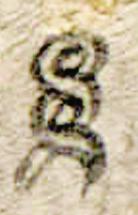Mali (BMapF23)
This black-line drawing of the simplex glyph for the personal name Mali is attested here as a woman’s name. It is short for Malinalli or it is a phonetic indicator for the name Maria, given that “l” and “r” were interchangeable in Nahuatl orthography of the period. The glyph shows a frontal view of a twisted piece of grass (malinalli), with a loop at the top, a figure eight, and two curving, unattached ends at the bottom.
Stephanie Wood
Malinalli is a day name in the 260-day religious divinatory calendar. If this glyph really stands for María, then the twisted grass is a phonetic indicator. Also, this would make it another example of Nahua glyphs for Spanish given names or surnames, such as appear below. Also appearing below are other examples of malinalli.
Stephanie Wood
This glyph is not glossed; the transliteration of the glyph comes from Gordon Whittaker’s contribution to the study by Mary E. Miller and Barbara E. Mundy (2012).
c. 1565
Jeff Haskett-Wood
hierbas, torcidas, tonalpohualli, calendarios, nombres de días, nombres de mujeres

Mali, Malinalli, o María
Stephanie Wood
Beinecke Map/Codex Reese, section 8, no. 40 in the Whittaker study (published in the Miller/Mundy book, 2012), and see the original at: https://brbl-dl.library.yale.edu/vufind/Record/3600017
The Bodleian Libraries, University of Oxford, hold the original manuscript, the MS. Arch. Selden. A. 1. This image is published here under the UK Creative Commons, “Attribution-NonCommercial-ShareAlike 3.0 License” (CC-BY-NC-SA 3.0).







